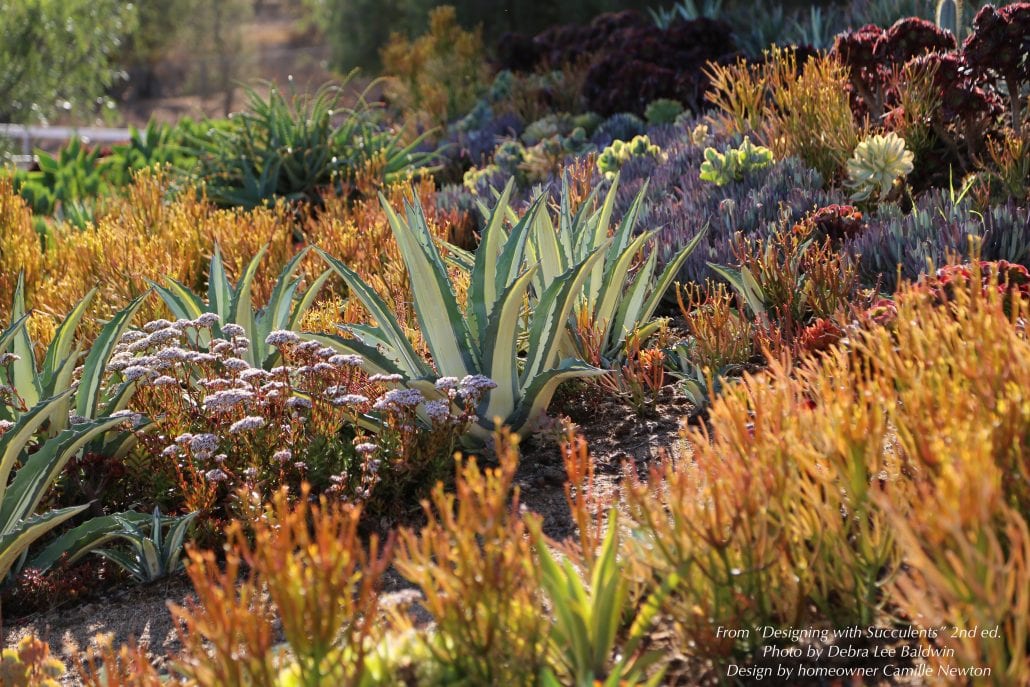Find tips to help protect your home in the event of a wildfire (scroll to the bottom) as well as real-life examples and advice from homeowners and experts. Discover how succulents act as a living firebreak.
Succulents are in-demand landscape plants in California because of their beauty, ease of care, and ability to withstand drought by storing moisture in their leaves. And now there's another reason for homeowners to grow these fleshy-leaved plants: they can serve as a firebreak.
Doctor's garden shielded by succulents
Dr. Camille Newton’s succulent garden, below, served as a firebreak during the 2017 Lilac Fire that destroyed neighboring homes in her north San Diego community of Bonsall. This photo of her garden is on page 51 of the second edition of Designing with Succulents ~

Camille's garden as it looked before the fire.
Soon after the wildfire, in a "Saved by Succulents" segment, Camille and I were on KFMB-TV News to describe how a landscape of moisture-rich plants can be both waterwise AND firewise. See the video.
Camille's story is both harrowing and remarkable... [Read more]
Misconceptions
Some fire districts mistakenly recommend growing native plants to the exclusion of all others. Indeed, natives do regenerate after a wildfire BUT are no help slowing one down, in fact, many natives---such as creosote plant---are highly combustible!
Most succulents are NOT invasive, and therefore pose no threat to the local ecology.
Succulents "Saved Our Home" says Rancho Santa Fe resident
In Oct. 2007, the succulent garden on the cover of the first edition of Designing with Succulents "saved" a Rancho Santa Fe home. Neighboring houses burned to the ground. Read Suzy Schaefer's story.

Find my own story of being evacuated from my San Diego home in 2007, plus “Why Succulents are Fire-Resistant,” in the Firewise Gardening section of Designing with Succulents (2nd ed).
Go to my YouTube Channel's Firewise Landscaping playlist.
Related info on this site
Debra’s Top Firewise Succulents
Debra’s Top Firewise Succulents Not surprisingly, plants that store water are slow to catch fire. The information on this page has been excerpted and used by fire protection agencies as far away as South Africa and Australia. You’re welcome to do so, too—all I ask is credit and, if possible, a link to this page.…
Did Succulents Protect These Homes from Wildfires?
Southern CA homeowners in Rancho Santa Fe and Bonsall say succulents protected their homes during two different wildfires. In each case, nearby homes burned to the ground.
Resources
Articles
Debra's Top Firewise Succulents
These are quite common in warm, dry areas of coastal and Southern CA and start easily from cuttings...[Read more]
How Succulents Protected a Home from Wildfire
"Succulents saved the day," says Dr. Camille Newton of Bonsall, CA. Her home was fine after the wildfire, but sadly, eight homes nearby were destroyed...[Read more]
Fire, Succulents and South Africa
Talfryn Harris, a fire manager in Johannesburg, is working on a presentation for their succulent society...[Read more]
Videos
Do Succulents Burn? (6:00)
We compare the combustibility of jade, aloe, aeonium, firesticks, elephant’s food and paddle cactus to branches cut from bamboo and oak trees.
How to Use Succulents as a Firebreak (4:32)
Filmed five days after Dr. Camille Newton's garden "saved" her house from wildfire. See how the fire impacted neighboring homes as well.
Doctor's Home "Saved by Succulents" During a Wildfire (4:57)
As guests on our local CBS News affiliate, homeowner Dr. Camille Newton and I explain how landscaping served as a wildfire barrier during the 2017 Lilac Fire near San Diego.
Characteristics of fire-resistant plants
According to CalFire, fire-resistant plants...
• Store water in leaves or stems.
• Produce very little dead or fine material.
• Possess extensive, deep root systems for controlling erosion.
• Maintain high moisture content with limited watering.
• Grow slowly and need little maintenance.
• Are low-growing in form.
• Contain low levels of volatile oils or resins.
• Have an open, loose branching habit with a low volume of total vegetation.



